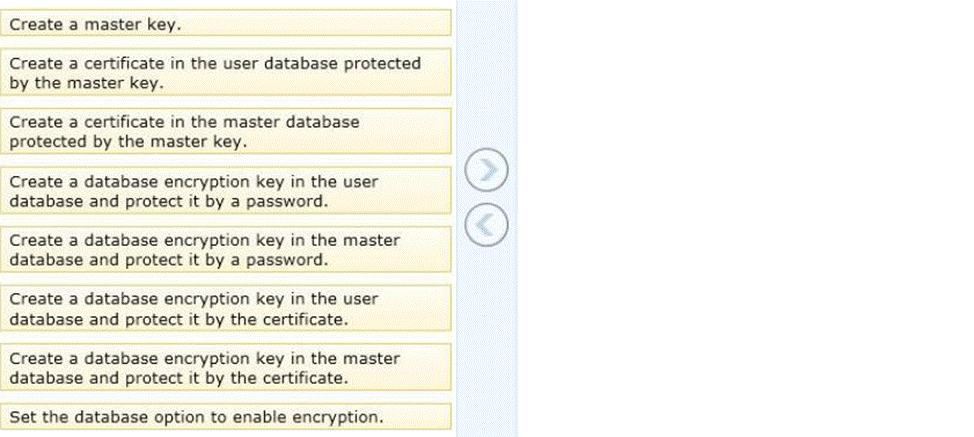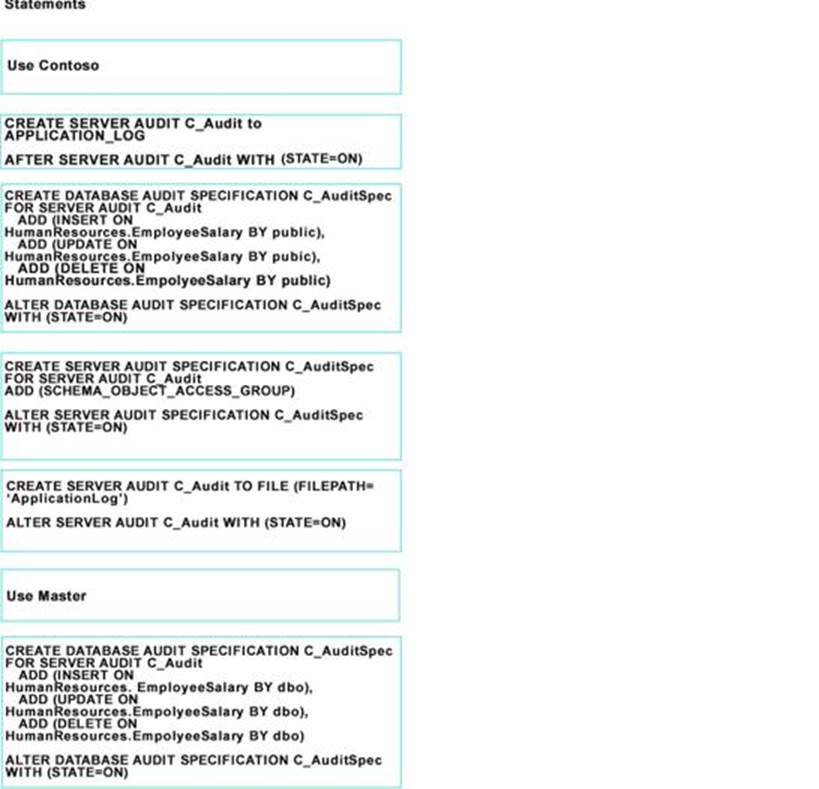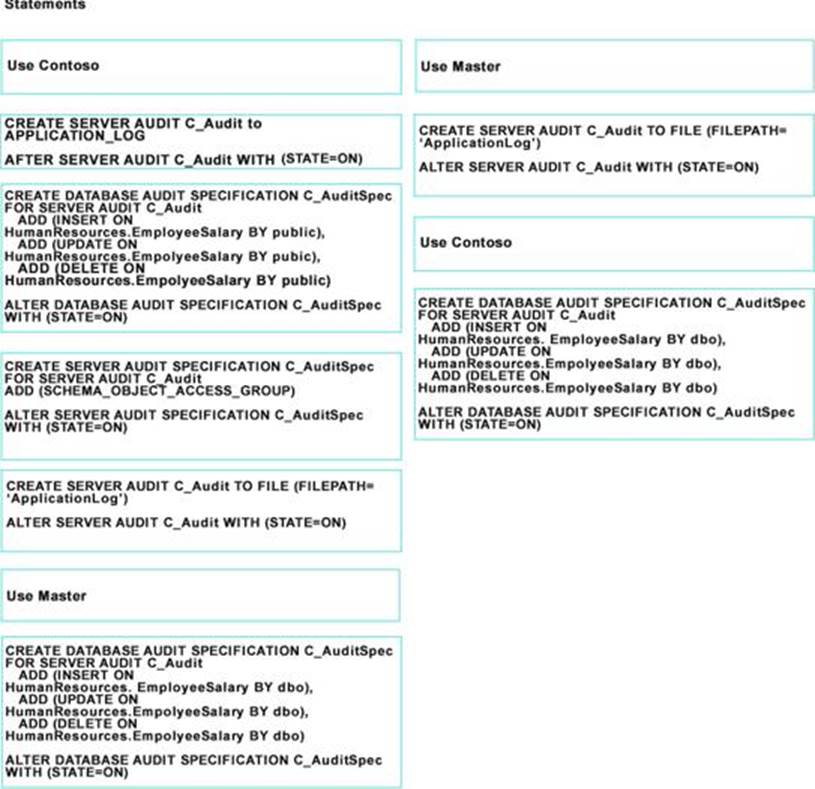Microsoft 70-462 Administering Microsoft SQL Server 2012 Databases Online Training
Microsoft 70-462 Online Training
The questions for 70-462 were last updated at Jan 22,2025.
- Exam Code: 70-462
- Exam Name: Administering Microsoft SQL Server 2012 Databases
- Certification Provider: Microsoft
- Latest update: Jan 22,2025
DRAG DROP
You administer a Microsoft SQL Server instance that contains a database of confidential data.
You need to encrypt the database files at the page level. You also need to encrypt the transaction log files.
Which four actions should you perform in sequence? (To answer, move the appropriate actions from the list of actions to the answer area and arrange them in the correct order.)

You administer a Microsoft SQL Server server. You plan to deploy new features to an application.
You need to evaluate existing and potential clustered and non-clustered indexes that will improve performance.
What should you do?
- A . Query the sys.dm_db_index_usage_stats DMV.
- B . Query the sys.dm_db_missing_index_details DMV.
- C . Use the Database Engine Tuning Advisor.
- D . Query the sys.dm_db_missing_index_columns DMV.
You administer a Microsoft SQL Server database named Contoso on a server named Server01.
You need to write messages to the Application Log when users are added to or removed from a fixed server role in Server01.
What should you create?
- A . A Database Audit Specification
- B . A Policy
- C . An Alert
- D . A SQL Profiler Trace
- E . A Resource Pool
- F . An Extended Event session
- G . A Server Audit Specification
You administer a Microsoft SQL Server 2012 database named Contoso on a server named Server01.
You need to be notified immediately when fatal errors occur on Server01.
What should you create?
- A . An Alert
- B . A Server Audit Specification
- C . An Extended Event session
- D . A Resource Pool
- E . A Policy
- F . A SQL Profiler Trace
- G . A Database Audit Specification
You administer a Microsoft SQL Server 2012 database named Contoso on a server named Server01.
You need to diagnose deadlocks that happen when executing a specific set of stored procedures by recording events and playing them back on a different test server.
What should you create?
- A . An Extended Event session
- B . A Policy
- C . A Database Audit Specification
- D . An Alert
- E . A Server Audit Specification
- F . A SQL Profiler Trace
- G . A Resource Pool
You administer a Microsoft SQL Server 2012 database named Contoso on a server named Server01.
You need to prevent users from disabling server audits in Server01.
What should you create?
- A . An Alert
- B . A Resource Pool
- C . An Extended Event session
- D . A Policy
- E . A Database Audit Specification
- F . A SQL Profiler Trace
- G . A Server Audit Specification
DRAG DROP
You administer a Microsoft SQL Server database server that has a database named Contoso. The Contoso database has a table named EmployeeSalary in a schema named HumanResources.
You need to create a script that writes audit events into the application log whenever data in the EmployeeSalary table is modified by the public principal.
Which four Transact-SQL statements should you use? (To answer, move the appropriate statements from the list of statements to the answer area and arrange them in the correct order.)

DRAG DROP
You administer a Microsoft SQL Server database. Your database is experiencing deadlock issues. You need to be able to monitor deadlocks.
Which three actions should you perform in sequence? To answer, move the appropriate actions from the list of actions to the answer area and arrange them in the correct order.

You administer a Microsoft SQL Server 2012.
A process that normally runs in less than 10 seconds has been running for more than an hour. You examine the application log and discover that the process is using session ID 60. You need to find out whether the process is being blocked.
Which Transact-SQL statement should you use?
- A . SELECT * FROM sys.dm_exec_requests WHERE session_id = 60
- B . SELECT * FROM sys.dm_exec_sessions WHERE session_id = 60
- C . DBCC INPUTBUFFER (60)
- D . DBCC OPENTRAN
You administer all the deployments of Microsoft SQL Server 2012 in your company. You have two servers in the same data center that hosts your production database.
You need to ensure that the database remains available if a catastrophic server failure or a disk failure occurs.
You also need to maintain transactional consistency of the data across both servers.
You need to achieve these goals without manual intervention.
Which configuration should you use?
- A . Two servers configured in a Windows Failover Cluster in the same data center
SQL Server configured as a clustered instance - B . SQL Server that includes an application database configured to perform transactional replication
- C . Two servers configured in the same data center
A primary server configured to perform log-shipping every 10 minutes
A backup server configured as a warm standby - D . Two servers configured in different data centers
SQL Server Availability Group configured in Synchronous-Commit Availability Mode
One server configured as an Active Secondary - E . Two servers configured in the same data center
SQL Server Availability Group configured in Asynchronous-Commit Availability Mode
One server configured as an Active Secondary - F . Two servers configured in different data centers
SQL Server Availability Group configured in Asynchronous-Commit Availability Mode - G . SQL Server that includes an application database configured to perform snapshot replication
- H . Two servers configured on the same subnet
SQL Server Availability Group configured in Synchronous-Commit Availability Mode
Latest 70-462 Dumps Valid Version with 301 Q&As
Latest And Valid Q&A | Instant Download | Once Fail, Full Refund




